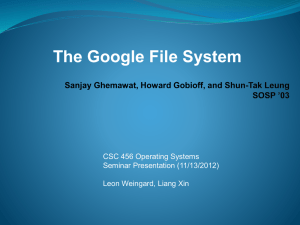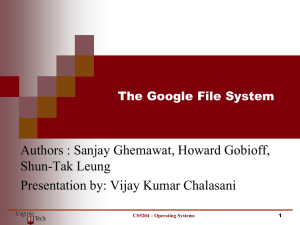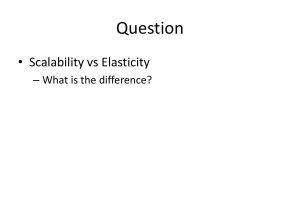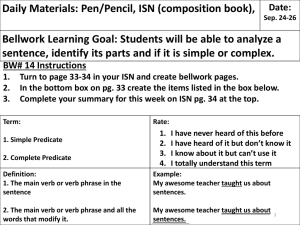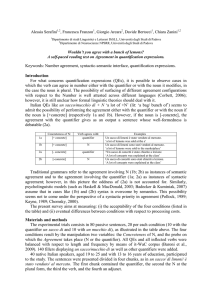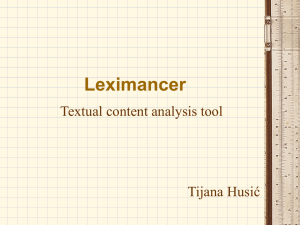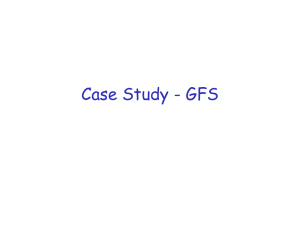Google File System
advertisement
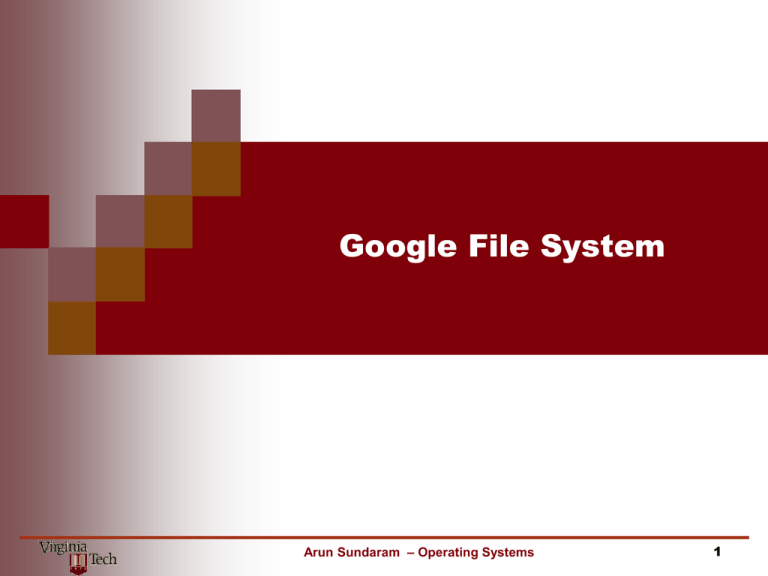
Google File System Arun Sundaram – Operating Systems 1 Google File System Assumptions GFS built with commodity hardware GFS stores a modest number of large files A few million files, each typically 100MB or larger (Multi-GB files are common) No need to optimize for small files Workloads Large streaming reads (1MB or more) and small random reads (a few KBs) Sequential appends to files by hundreds of data producers High sustained bandwidth is more important than latency Response time for individual read and write is not critical Arun Sundaram – Operating Systems 2 Google File System Architecture Single master, multiple chunk servers, multiple clients User-level process running on commodity Linux machine GFS client code linked into each client application to communicate File -> 64MB chunks -> Linux files on local disks of chunk servers replicated on multiple chunk servers (3r) Cache metadata but not chunk on clients Arun Sundaram – Operating Systems 3 Google File System Single Master Why centralization? Simplicity! Global knowledge is needed for Chunk placement Replication decisions Arun Sundaram – Operating Systems 4 Google File System Chunk size 64MB – Much Larger than ordinary, why? Advantages Reduce client-master interaction Reduce network overhead Reduce the size of the metadata Disadvantages Internal fragmentation Solution: lazy space allocation Hot Spots – many clients accessing a 1-chunk file, e.g. executables Solution: Higher replication factor Stagger application start times Client-to-client communication Arun Sundaram – Operating Systems 5 Google File System Metadata File & chunk namespaces In master’s memory and storage File-chunk mapping In master’s memory and storage Location of chunk replicas In master’s memory Ask chunk servers when Master starts Chunk server joins the cluster If persistent, master and chunk servers must be in sync Arun Sundaram – Operating Systems 6 Google File System Metadata – In Memory DS Why in-memory data structure for the master? Allows fast scans for GC and LB Will it pose a limit on the number of chunks -> total capacity? No, a 64MB chunk needs less than 64B metadata (640TB needs less than 640MB) Most chunks are full Prefix compression on file names Arun Sundaram – Operating Systems 7 Google File System Metadata - log The persistent record of metadata Defines the order of concurrent operations Critical Replicated on multiple remote machines Respond to client only when log locally and remotely Fast recovery by using checkpoints Use a compact B-tree like form directly mapping into memory Switch to a new log, Create new checkpoints in a separate threads Arun Sundaram – Operating Systems 8 Google File System System Interactions - Lease Minimized management overhead Granted by the master to one of the replicas to become the primary Primary picks a serial order of mutation and all replicas follow 60 seconds timeout, can be extended Can be revoked Arun Sundaram – Operating Systems 9 Google File System Write – Mutation order Write request Current lease holder? 3a. data Operation completed or Error report identity of primary location of replicas (cached by client) Operation completed 3b. data Primary assign s/n to mutations Applies it Forward write request 3c. data Operation completed Arun Sundaram – Operating Systems 10 Google File System System Interactions – Atomic Record Append Concurrent appends are serializable Client specifies only data GFS appends at least once atomically Return the offset to the client Step 6 extends to: If record fits in current chunk: write record and tell replicas the offset If record exceeds chunk: pad the chunk, reply to client to use next chunk Heavily used by Google On failures, the client retries the operation Arun Sundaram – Operating Systems 11 Google File System Consistency Model File namespace mutations (e.g., file creation) are atomic Namespace management and locking The master’s operation log File Regions Consistent: all clients see same data, regardless which replicated chunk they use Defined: after data mutation (writes or record appends) if it is consistent & all clients will see the entire mutation effect After a sequence of successful mutations, the mutated file is guaranteed to be defined and contain the data written by the last mutation. This is obtained by Applying the same mutation order to all replicas Using chunk version numbers to detect stale replica Arun Sundaram – Operating Systems 12 Google File System System Interactions – Snapshot Master makes a copy of a file or a directory tree almost instantaneously Use copy-on-write Steps Revokes lease Logs operations to disk Duplicates metadata, pointing to the same chunks Create real duplicate locally Disks are 3 times as fast as 100 Mb Ethernet links Arun Sundaram – Operating Systems 13 Google File System Master Operation – Namespace Management GFS has no directory (i-node) structure Simply uses directory-like file names: /foo, /foo/bar Concurrent Access Read lock on a parent path, write lock on the leaf file name protect delete, rename and snapshot of in-use files Rebalancing Places new replicas on chunk servers with below-average disk space utilizations Re-replication When the number of replicas falls below 3 (or user-specified threshold) The master assigns the highest priority to copy (clone) such chunks Spread replicas of a chunk across racks Arun Sundaram – Operating Systems 14 Google File System Master Operation – Garbage Collection File deletion Rename the file to a hidden name (deferred deletion) The master regularly scans and removes hidden files, existed more than three days HeartBeat messages inform chunk servers of deleted chunks Stale Replica Detection Version number is assigned for each chunk increases when the master grants a new lease of the chunk Arun Sundaram – Operating Systems 15 Google File System Fault Tolerance – High Availability Fast Recovery The master and the chunk server are designed to restore their state in seconds no matter how they terminated. Servers are routinely shut down just by killing the process Master Replications Master has the maps from file names to chunks Only one master manages chunk mutations Several shadow masters exist for redundancy Snoop operation logs and apply these operations exactly as the primary does Data Integrity Checksums for each 64KB segment in a chunk chunk servers verifies the checksum of data before sending it to the client or other chunk servers Arun Sundaram – Operating Systems 16 Google File System Real World Clusters Cluster Stats Performance 1 week after restart % Operations breakdown by size % Master Request Types 85% 97% 95% 50% 45% 67% Cluster X: R&D machine, Cluster Y: Production Data Processing Arun Sundaram – Operating Systems 17 Google File System Conclusion GFS is radically different than traditional FS Component failure is normal Optimize for huge files Append as much as possible Much attention paid to Monitoring Replication Recovery Minimize master involvement with common operations to avoid bottleneck Design is a success and widely used in Google Arun Sundaram – Operating Systems 18 Google File System GFS lessons (2010) Scaled to approximately 50M files, 10P Large files increased upstream app. complexity Not appropriate for latency sensitive applications Scaling limits added management overhead Google's Answer: Collosus Ref: http://static.googleusercontent.com/external_content/untrusted_dlcp/research.google.com/en/us/un iversity/relations/facultysummit2010/storage_architecture_and_challenges.pdf Arun Sundaram – Operating Systems 19
